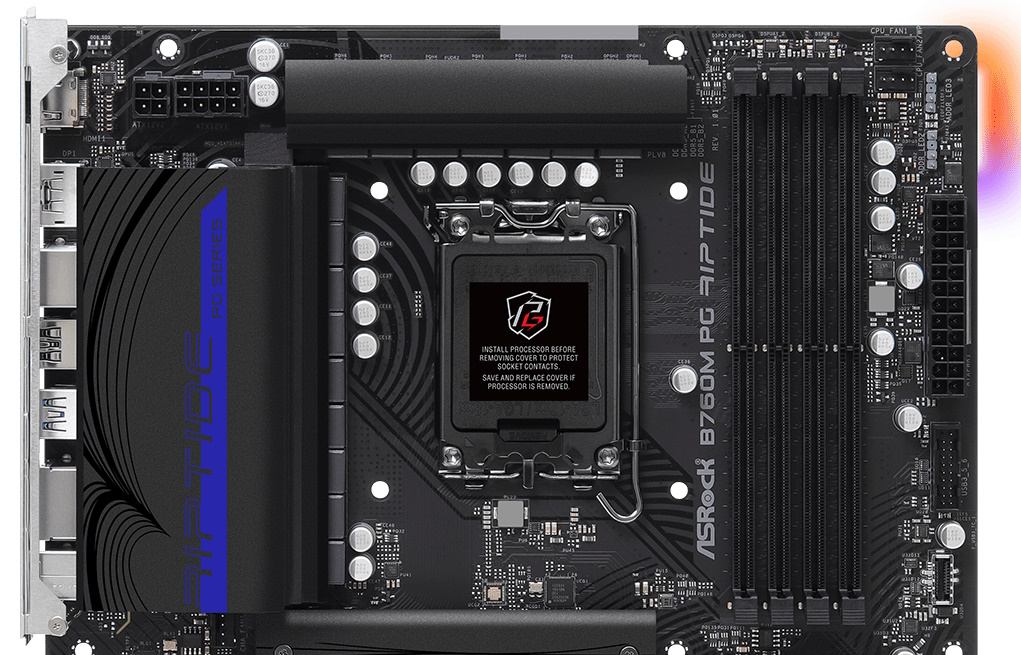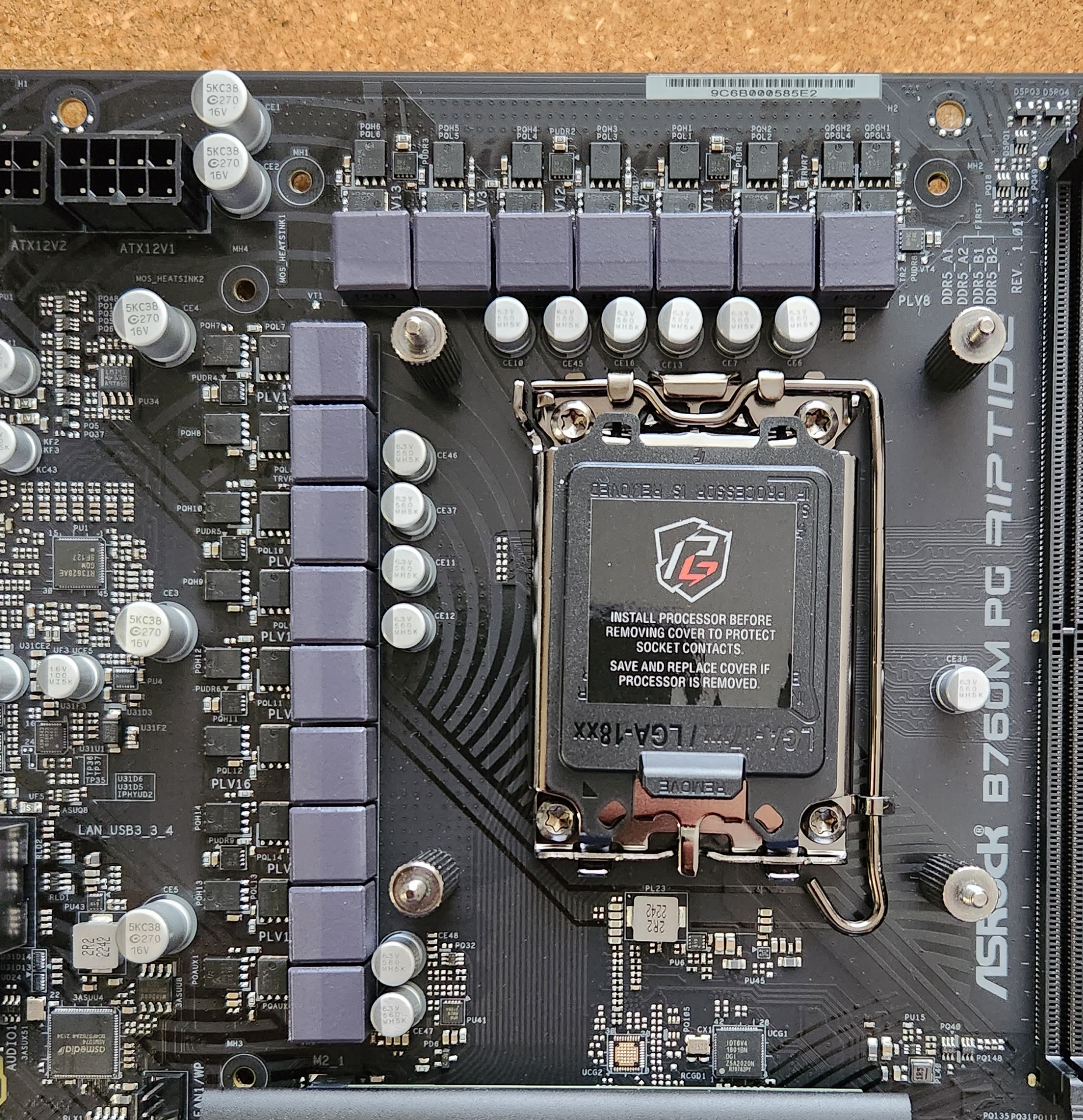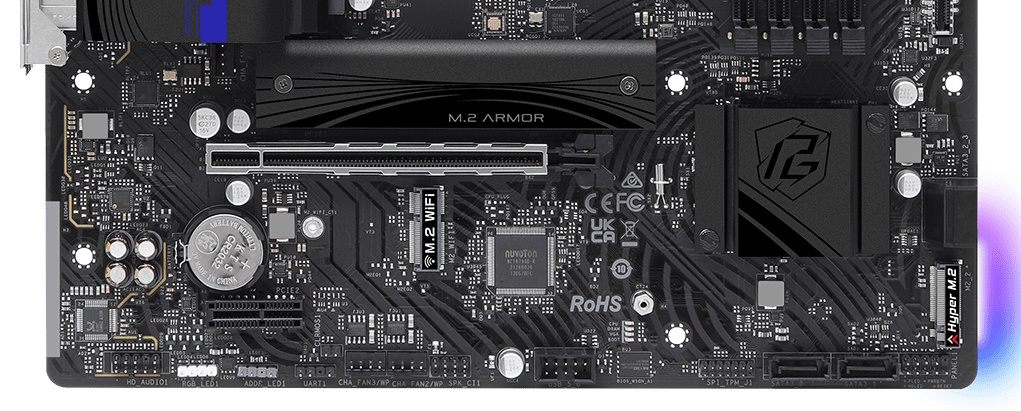The ASRock B760M PG Riptide is a Micro ATX motherboard that helps the most recent Intel twelfth and thirteenth Gen Intel processors. Priced at simply over $145, it provides a easy black-on-black look, with a blue strip on the VRM and some RGB LEDs hidden beneath the proper aspect of the board. You get two M.2 sockets and 4 SATA ports for storage, Realtek 2.5 GbE networking (Wi-Fi not included), reminiscence help listed as much as DDR5-7200+(OC), and a price range Realtek audio codec. Finally, it’s a full-featured choice within the price range Micro ATX area.
The PG Riptide stacks up properly towards the competitors on the {hardware} entrance. At this value and with this price range chipset, there’s not a lot that may go on these boards aside from the fundamentals, because the platform limits the potential for high-speed interfaces.
To maintain the value level low, ASRock makes use of 12-phase VRMs for Vcore, and as a substitute of utilizing extra trendy (and dear) SPS MOSFETs, we see an old-school configuration utilizing Hello and Low aspect ICs as a substitute of mixed as we’re used to on dearer fashions. This isn’t supreme for high-end processors, but it surely did permit our Intel Core i9-13900K to run the Intel’s defaults, boosting as much as 255W for a short while, then limiting itself to 125W and decrease clocks. You received’t discover PCIe 5.0 x4 slots, a high-end audio resolution, and even 20 Gbps Sort-C ports at this discount basement value, however you possibly can run the most recent and biggest processors for the platform and DDR5 reminiscence.
Efficiency-wise, The B760M PG Riptide is all around the map, because it follows Intel’s specs. You get a full 255W for the processor, after which it ramps down off the turbo increase, limiting it to 125W. For a motherboard of this class, that’s to be anticipated, particularly because of the paltry VRMs powering the processor. It competes with high-end boards in single-threaded functions or in shorter-running, closely threaded functions. Gaming efficiency was above common, and Intel’s limits aren’t getting in the way in which of gaming. Should you plan to drop in a high-end processor and make the most of all of the cores and threads, you’ll discover a ceiling on efficiency in comparison with different boards that bypass Intel’s specs.
Under, we’ll dig into the main points of the board and see if the PG Riptide finds its approach onto our Finest Motherboards record. Earlier than we get into our testing and board particulars, although, we’ll begin by itemizing the specs from ASRock.
Specs: ASRock B760M PG Riptide
| Socket | LGA1700 |
| Chipset | B760 |
| Type Issue | Micro ATX |
| Voltage Regulator | 16 Part (12x 50A VRMs for Vcore) |
| Video Ports | (1) HDMI (v2.1) |
| (1) DisplayPort (v1.4) | |
| USB Ports | (1) USB 3.2 Gen 1 (10 Gbps), Sort-C |
| (3) USB 3.2 Gen 1 (5 Gbps) | |
| (4) USB 2.0 (480 Mbps) | |
| Community Jacks | (1) 2.5 GbE |
| Audio Jacks | (3) Analog |
| Legacy Ports/Jacks | (1) PS/2 |
| Different Ports/Jack | ✗ |
| PCIe x16 | (1) v4.0 (x16) |
| PCIe x8 | ✗ |
| PCIe x4 | ✗ |
| PCIe x1 | (1) v4.0 (x1) |
| CrossFire/SLI | ✗ |
| DIMM Slots | (4) DDR5 7200+(OC)*, 192GB Capability |
| *1DPC 1R As much as 7200+ MHz (OC), 4800 MHz Natively. | |
| 1DPC 2R As much as 6000+ MHz (OC), 4400 MHz Natively. | |
| 2DPC 1R As much as 5600+ MHz (OC), 4000 MHz Natively. | |
| 2DPC 2R As much as 4800+ MHz (OC), 3600 MHz Natively. | |
| M.2 Sockets | (2) PCIe 4.0 x4 (64 Gbps) / PCIe (as much as 80mm) |
| SATA Ports | (4) SATA3 6 Gbps (Helps RAID 0/1/5/10) |
| USB Headers | (1) USB v3.2 Gen 1, Sort-C (5 Gbps) |
| (1) USB v3.2 Gen 1 (5 Gbps) | |
| (1) USB v2.0 (480 Mbps) | |
| Fan/Pump Headers | (5) 4-Pin (CPU, CPU/Water Pump, Chassis/water pump) |
| RGB Headers | (3) aRGB (3-pin) |
| (1) RGB (4-pin) | |
| Diagnostics Panel | (1) Publish Standing Checker (4 LEDs) |
| Inner Button/Swap | ✗ |
| SATA Controllers | ✗ |
| Ethernet Controller(s) | (1) Realtek Dragon RTL8125BG (2.5 GbE) |
| Wi-Fi / Bluetooth | ✗ |
| USB Controllers | ASMedia ASM1074 |
| HD Audio Codec | Realtek ALC897 |
| DDL/DTS | ✗ / ✗ |
| Guarantee | 3 Years |
Contained in the Field of the ASRock B760M PG Riptide
Contained in the retail field, above the motherboard, is a small handful of equipment. ASRock features a handbook, postcard, two SATA cables, screws for the M.2 sockets(2), and a case sticker. There isn’t a lot right here, although the fundamentals are coated.
Design of the B760M PG Riptide
The B760M PG Riptide comes with a matte-black PCB with black slots, sockets, and heatsinks. The one shade is a blue/purple strip with some branding on the left VRM heatsink. The board and heatsink have some strains stenciled on, but it surely’s robust to see the design as they’re barely lighter than the board itself. Should you’re searching for RGB lighting, the Riptide has you coated with two zones with three LEDs every on the proper edge, on the high and backside. The RGBs are vivid and the colour is saturated, which makes for a pleasant glow from beneath the board, lighting up the within of your chassis. Total, it’s a handsome motherboard for the value, however actually not a showpiece.

Within the higher left nook of our price range board, the very first thing we see is the 8-pin (required) and 4-pin (elective) EPS connections to energy the processor. Subsequent, we get a better have a look at the VRM heatsinks. The left heatsink is the bigger of the 2, reaching out over the rear IO space and protecting a few of these unpleasant Rear IO bits. On high, the Riptide PG Collection branding, in that deep blue/purple shade, matches the PCB’s design/patterns.
Transferring previous the socket space, we discover 4 DRAM slots with locking mechanisms on each side. ASRock lists help as much as DDR5-7200, however as at all times, your mileage might differ relying on the package used. Your greatest likelihood of success in these quick kits is to stay with the QVL record.
Simply previous the DRAM slots within the upper-right nook are the primary two (of 4) 4-pin fan/pump headers. Every header helps PWM and DC-controlled units. The CPU fan (CPU_FAN1) helps as much as 1A/12W and the remainder of the headers help 2A/24W. I’d prefer to see one other fan header or two, however you possibly can piggyback a few followers on the headers. Simply make sure to not overload them because it might harm your board.
Subsequent, we run into two (of 4) RGB headers. On this case, there are two 3-pin ARGB headers with a further ARGB header and a single 4-pin RGB header alongside the underside edge. The Polychrome utility controls the RGBs and labored properly in our restricted use syncing with the opposite merchandise.
Persevering with down the proper edge, we run into the 24-pin ATX connector to energy the board, a entrance panel USB 3.2 Gen 1 (5 Gbps) connector, and a USB 3.2 Gen 2 (10 Gbps) Sort-C header for the entrance panel.

Energy supply on our PG Riptide is configured as 14 complete phases, with 12 devoted to Vcore, identical to the PG Sonic we just lately reviewed (and its twin, the Metal Legend). Energy comes from the 8-pin EPS connector and heads all the way down to the Richtek RT3628AE 9-channel PWM controller. Subsequent are the 12 VRMs devoted to Vcore arrange utilizing a Teamed configuration. The VRMs don’t make the most of the newer MOSFETs that mix Hello and Low sides, so every part has two ICs. There isn’t plenty of energy out there, but it surely dealt with our Intel Core i9-13900K following the Intel specs. Unsure I’d let the system run with out these limits for lengthy, nonetheless. Not less than not with out energetic cooling on the ability supply.

On the underside of the board, on the left aspect, we see the Realtek ALC897 audio codec, 4 capacitors devoted to audio, and a visual audio separation line designed to attenuate EMI. This isn’t the most recent or greatest audio resolution. Nevertheless, many these prioritizing value over fancy options ought to discover the output adequate.
In the course of the board, we see a full-length PCIe slot and an open-ended x1 slot. The highest major slot makes use of reinforcement to guard towards shearing from heavy graphics playing cards. This slot connects by means of the CPU and runs at PCIe 4.0 x16, whereas the underside x1 slot sources its lanes by means of the chipset and runs at PCIe 4.0 x1. Just under the highest slot is a Key-e M.2 socket that helps 2230 Wi-Fi/BT PCIe modules utilizing the Intel CNVio/CNVio2 protocols. Our board doesn’t include one, however you should buy one individually for $25 or much less and simply add it if wanted.
Transferring on to storage, our board has two M.2 sockets. The highest socket (M2_1), beneath the heatsink, connects by means of the CPU with PCIe 4.0 x4 (64 Gbps) bandwidth. The opposite socket (M2_2) on the proper edge doesn’t have a heatsink and runs as much as the identical velocity. Every helps as much as 80mm units. 4 SATA3 6 Gbps ports spherical out the storage choices, with two situated on the proper edge and two on the underside. Should you’d like to make use of RAID, you are able to do so on the SATA ports (RAID0/1/5/10), however RAID help for the M.2 sockets isn’t listed.
Throughout the underside of the board are a number of uncovered headers. You’ll discover the same old, together with further USB ports, RGB headers, and energy/reset buttons. Under is an entire record from left to proper.
- Entrance panel audio
- 4-pin RGB header
- 3-pin ARGB header
- Clear CMOS jumper
- (2) System Fan headers
- Speaker header
- USB 2.0 header
- TPM header
- (2) SATA3 6 Gbps ports
- System panel header

The rear IO plate on the B760M PG Riptide comes preinstalled to the motherboard, which is a pleasant contact at this value. It sports activities a black theme with white labels together with Phantom Gaming branding. There’s a complete of eight USB ports scattered throughout the rear IO. You get one USB 3.2 Gen 2 (10 Gbps) Sort-C port, three USB 3.2 Gen 1 (5 Gbps) ports, and 4 USB 2.0 (480 Mbps) ports. For video, the PG Riptide has HDMI and DisplayPorts for these utilizing the built-in graphics on the processor. Final up are the two.5 GbE port, a PS/2 port for the keyboard and mouse, and three 1/8-inch outputs that comprise the audio stack.
MORE: Finest Motherboards
MORE: How To Select A Motherboard
MORE: All Motherboard Content material














